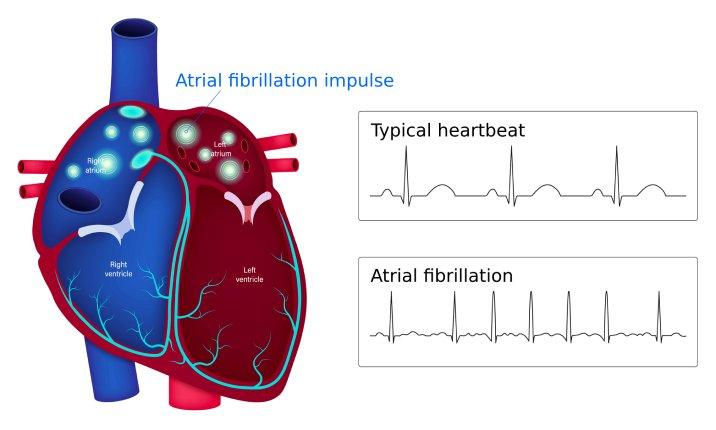Does your heartbeat or pulse feel irregular, faster than what you normally expect or just not its usual self? We can expect to feel our heart fluttering when we are anxious, excited or upset, but if this repeatedly occurs during inexplicable or unexpected circumstances, you should not ignore it. You may be experiencing the most common arrhythmia diagnosed in clinical practice, atrial fibrillation (AF or AFib).
What is atrial fibrillation (AF or AFib)?
Atrial fibrillation (AF or AFib) is a common heart rhythm disorder characterised by an irregular and often rapid heartbeat. In this condition, irregular electrical impulses cause the heart's upper chambers (the atria) to quiver instead of contracting effectively. This causes blood to stagnate in the atria and makes you prone to form blood clots.
When a blood clot dislodges and travels to the brain, it results in a stroke. Aside from a 500% increase in stroke risk, atrial fibrillation increases the risk of heart failure and sudden death.
How is atrial fibrillation treated?
Atrial fibrillation is a serious condition that should not be ignored as it can be life-threatening if left untreated. The strokes caused by atrial fibrillation often cause significant disability and loss of independent living.
Unfortunately, atrial fibrillation cannot heal independently and will only worsen with time. To manage atrial fibrillation for the vast majority of patients, we aim to prevent the formation of blood clots (and, therefore, strokes) and restore normal heart rhythm.
Stroke prevention
A simple-to-use bedside score, called the CHADS₂-VASc score, can help to predict an individual’s stroke risk. It considers your age, gender, whether you have hypertension, diabetes, previous strokes, disease of your blood vessels, and heart failure. Based on this score, your doctor will recommend whether you need to take specific blood thinners to prevent blood clot formation and thus, strokes.
Some patients cannot tolerate blood thinners and may be advised to undergo a minimally invasive procedure called left atrial appendage occlusion. The left atrial appendage is the source of 95% of blood clots in atrial fibrillation patients. By permanently sealing off the left atrial appendage with an umbrella-like device, patients can get the same level of stroke prevention as those taking blood thinners long-term.
Restoration of normal heart rhythm
Treatment options to restore normal heart rhythm include:
- Electrical cardioversion. This is a procedure during which a controlled electric shock is delivered to the heart whilst the patient is sedated. This shock resets the electrical activity in the atria and restores normal heart rhythm. It's often used when atrial fibrillation cannot stop on its own or does not respond to medications.
- Anti-arrhythmic medications. Heart rhythm medications may be prescribed as part of your treatment plan to help restore and maintain normal heart rhythm.
- Catheter ablation. This is a minimally invasive procedure where a thin, flexible tube (catheter) is inserted into the heart through the veins. Once there, specific areas of the heart responsible for causing atria fibrillation are targeted to stabilise the heart rhythm and prevent atrial fibrillation occurrence. Catheter ablation is the most effective treatment to prevent atrial fibrillation recurrence in the long term.
- Maze procedure. This is an open-heart surgical treatment for atrial fibrillation. It is usually used in conjunction with other forms of open heart surgery, such as coronary artery bypass grafting or valve replacements.
What is pulsed field ablation (PFA)?
Catheter ablation is the most common performed procedure for heart rhythm disorders globally. Each year, more than 300,000 patients worldwide undergo catheter ablation for atrial fibrillation. Traditionally, atrial fibrillation ablation has been performed using technologies that either heat or freeze the heart tissue. Whilst effective for treating atrial fibrillation, there is a small (<1%) risk of collateral damage to structures around the heart. The search for safer energies to perform atrial fibrillation ablation led to the invention of pulsed field ablation (PFA).
PFA utilises high density, high-voltage electrical pulses to treat specific areas of the heart responsible for causing atrial fibrillation.
PFA allows for more targeted treatment, at least 50-75% shorter operating times, and enhanced safety. PFA specifically targets cardiac tissue while sparing nearby structures like blood vessels, nerves, and connective tissue. Hence, the risk of collateral damage is eliminated.
What can you expect during pulsed field ablation (PFA)?
Pulsed field ablation is a minimally invasive procedure performed during sedation or general anaesthesia. You will not be awake during the procedure.
Estimated duration
Typically, a pulsed field ablation procedure can last between 45 -- 90 minutes, depending on the patient’s complexity.
Before the procedure
- Consultation. Before the ablation, your medical team will explain the procedure, risks and alternative treatments, ensuring you're comfortable and well-informed.
- Fasting. You'll generally be advised to abstain from eating or drinking for at least 6 hours before the procedure. This precaution ensures your safety, as sedation or anaesthesia is employed.
- Medication guidelines. It's crucial to adhere to any advice given about your current medications. Some may be stopped before the procedure.
During the procedure
- Comfort and safety. Patients will receive either sedation or general anaesthesia so that you are entirely comfortable and pain-free throughout.
- Catheter insertion. A catheter will be introduced in your veins using a fine needle and passed into the heart via the body's main vein.
- Ablation process. Targeted electrical pulses will be delivered to the problematic heart tissue using pulsed field technology to rectify atrial fibrillation.
After the procedure
- Initial monitoring. You'll be observed closely in a recovery room after the ablation. Medical staff will monitor your vital signs and ensure there are no immediate complications.
- Recovery instructions. Once deemed stable, you'll receive guidelines for post-procedure care. This may include wound care, activity restrictions, and medication adjustments. Most patients will be discharged the following day.
- Follow-up. Attending any scheduled follow-up appointments with your cardiologist is essential. These visits will help ensure that the pulsed field ablation was successful and address any concerns you might have.
Speak to a heart specialist
If you have an irregular heartbeat, don’t hesitate to get it checked. Understanding the cause of your irregular heartbeat is essential in ensuring appropriate treatment and avoiding long-term complications. Speak to a cardiologist today.














